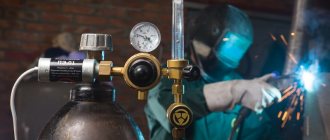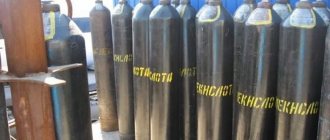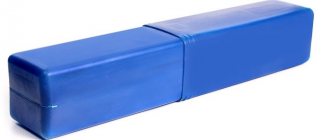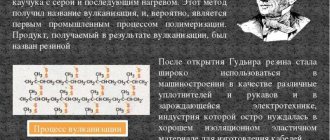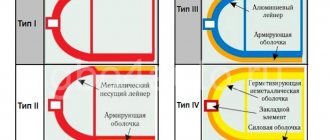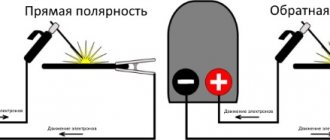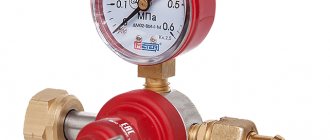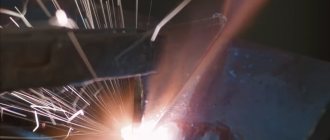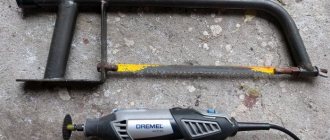Physical and chemical characteristics
At room pressure and temperature, this substance is a colorless gas. It has its own, slightly sour, smell. If the carbon dioxide in the cylinder is in a liquid state, it must be under a pressure that is not less than 5850 kPa.
When cooled to a temperature of -56 degrees and a pressure of 519 kPa, carbon dioxide turns into a solid state. This substance is called “dry ice”. The pressure of carbon dioxide in the cylinder needs to be known in order to be sure that the substance is in the desired state.
Specifications
CO2 cylinders are available in different volumes, from 2 to 40 liters. In the food industry, small forms are more often used - volumes of 2, 5 and 10 liters.
Characteristics of a 5-liter cylinder:
- Height: 530 mm
- Diameter: 135 mm
- Weight: 9 kg
- Working pressure: 150 bar.
The service life of the cylinder is 40 years. Once every five years, the cylinder must undergo inspection by the State Technical Supervision Authority. In this case, an external inspection of the surface of the cylinder, degassing, washing, drying, monitoring the condition of the valve, painting the cylinder and its branding takes place. Refilling with carbon dioxide is carried out at specialized gas stations.
Types of products
Carbon dioxide is produced in the following form:
- Liquefied gas, which is stored under a pressure of 50 kg/sq.cm. To do this, it is necessary to ensure an air temperature not exceeding 31 degrees.
- Liquid carbon dioxide for storage in special thermoses.
- In the form of dry ice.
The product is then placed in black tanks with yellow warning labels and delivered to consumers for use.
Gas flow reducer Source donmet.com.ua
Does the pressure in the can depend on temperature?
Carbon dioxide obeys physical laws; taking them into account, it can be determined that any gas has a critical state, which is characterized by critical pressure and critical temperature.
The critical temperature is the temperature above which gas evaporation cannot turn into a liquid state, under any pressure. Critical pressure is the pressure when the difference between the liquid and vapor states disappears. In this case, both substances are identical in density, their index is zero.
What does it mean? The critical temperature of carbon dioxide is 31.2 ° C, and the pressure is 74 atmospheres, this means that in the can at 31.2 ° C a pressure equal to 74 atmospheres appears, and carbon dioxide acquires a critical state and at this temperature indicator CO2 consumption during shooting increases significantly, since it is not pure gas that comes out through the air valve, but an averaged substance between liquid and gas, which has a density of 0.47 g/dm. cube (carbon dioxide has a density of 1.99 g/cm3).
Moreover, such strong cooling begins that in the barrel channel, directly from this state, carbon dioxide acquires a solid state, the so-called “dry ice”, and the pressure in the barrel channel decreases significantly, this causes a decrease in the initial speed of the ball. Therefore, on hot days, the first shots from an air pistol (until the gas cartridge cools below a critical point) can be quite weak, and the consumption of carbon dioxide occurs much more, and particles of “dry ice” can be observed flying out of the pistol. For normal shooting, the gas cartridge must be cooled to + 21…23°C.
Thus, we can conclude that a gas substance with a critical temperature of + 31 ... 36 ° C and a critical pressure of 210 atmospheres, non-toxic and cheap, is better suited for use in an air gun. But gas with these indicators is still unknown.
Air under pressure (140.8 ° C / 37.3 atmospheres), naturally, is convenient for PCP weapons, but in a small repeating pistol its use is impossible due to the significant dimensions of the can and the reduction in pressure after each shot or the installation of a reducer (which also has big sizes). Therefore, only carbon dioxide is currently being considered for use in air pistols.
A little about myths. The first and most common: in foreign gas cartridges the pressure is much higher, unlike Russian ones. This is absolutely false; under any conditions, the pressure in any canister, regardless of the volume and country of manufacture, will always be the same. This will depend on physical laws, and not on the manufacturing company.
The next misconception: it’s not uncommon to hear at shooting ranges: “Install me a new canister, someone has already shot with this one.” An incorrect judgment does not even consist in the lack of minimal knowledge of the laws of physics, but in the reluctance to listen to any explanations; even textbooks do not convince many people: “I don’t know what is written in the book, but the gun shoots weakly and that’s all!” For these distrustful people, special tests were even carried out, it must be said again: as long as there is at least a drop of liquid gas in the can, at an equal temperature regime that does not exceed the critical value (31.2 ° C for carbon dioxide), the pressure in the can does not change. Reducing the temperature during shooting does not lower it enough to be visible to the naked eye.
What should the consumer do?
If a company uses carbon dioxide in its work, it needs to find those who will organize the supply. The receiving procedure looks like this:
- The supply company leaves a request to receive a certain amount of the product.
- At the appointed time, receive cylinders filled with gas.
- Return those tanks from which carbon dioxide has already been used.
Various types of cylinders are used for refilling:
- A 40-liter container holds 24 kilograms of gas. The cylinder has a diameter of 21.9 cm and a height of 140 cm.
- The 20-liter has a diameter of 21.9 cm and a height of 85 cm. It holds half as much gas - 12 kilograms.
- The 10-liter container is smaller. The diameter is 14 cm and the height is 86.5 cm. The buyer is provided with 6 kg of carbon dioxide.
There are several other types of cylinders that can be refilled.
Appearance of carbon dioxide cylinders Source nord-gaz.com
Technical specifications
Depending on the capacity of the container, various technical requirements are imposed on it. If the tank is produced with a volume of 5 liters, then the grade of steel that should be used for its production is 45 D. The pressure of carbon dioxide in a cylinder with such a displacement should be 14.7 MPa (kgf/cm2). The diameter of such a cylindrical container is 140 mm, length is 475 mm, and weight is 8.5 kg.
Cylinders with a capacity of 10 liters are manufactured from the same grade of steel as 5-liter ones. The pressure in such tanks, as well as their diameter, also corresponds to the previous type. The length of such a cylinder should be 865 mm, and the weight should be 8.5 kg.
A 40-liter carbon dioxide cylinder can be made of 45 D steel or 40 X GSA steel. If production is carried out from the first grade of steel, then the pressure in it also remains at the level of 14.7 MPa (kgf/cm2), and if from steel 40 X GSA, then the working pressure increases to 19.5 MPa (kgf/cm2). The diameter of both gas tanks will be 219 mm. The length of a cylinder made from steel 45 D will be equal to 1370 mm, and from steel 40 X GSA 1350 mm. The weight of the container made from the first grade of steel is 58.5 kg, and from the second - 51.5 kg.
Gas containers
They can have a volume from 0.4 to 50 liters. Such cylinders can be used for decades.
These containers can be used not only for distribution to consumers, but also for storage or intermediate transportation. Containers must necessarily comply with the requirements of GOST 949-73.
For this purpose, solid-cast cylinders are used, containing structural steel grade 45D, as well as alloy steel grade 40KhGSA. Each model is used with the condition that the gas pressure does not exceed the limit value. For a capacity not exceeding 20 liters, it is 20 MPa; for larger ones it can reach 20 MPa.
Carbon dioxide fire extinguisher Source tps72.com
Charging procedure
Before refilling, you need to carefully inspect the tank. Even minor damage can lead to an explosion. If the cylinder is in good condition, proceed to filling it with carbon dioxide.
Liquefied gas is poured into the cylinder. To do this, you need to create a pressure difference. The container only needs to be filled 80%. The remaining part is allocated for the gaseous part. If this is not done, the pressure in the cylinder may exceed the norm.
Technical data sheet of the cylinder Source ballony.com.ua
Features of a CO2 cylinder
The carbon dioxide cylinder must be completely painted black and also have the inscription “CARBON ACID” made of yellow enamel. It is worth noting that the weight of the container is established without taking into account such parts as valves, rings, caps, shoes. In addition to the coloring and inscription, the tank must contain passport information about it.
This data is applied using the impact method. It is important to know that information is applied at the top of the cylinder, and its location is completely cleaned to a metallic shine and has a highlighting line 20-25 mm wide in yellow. Here is a list of information that a passport should contain:
- date of container production and year of subsequent inspection;
- what is the pressure of carbon dioxide in the cylinder (indicated in MPa (kgf/cm2);
- tank capacity (indicated in liters);
- empty container weight (indicated in kilograms);
- serial number of the tank and the brand of the company that manufactured it;
- the brand of the company that carried out the technical examination;
- the last stamp from the technical control department of the company that manufactured the tank.
Cylinder weight
When using, transporting and charging, it is necessary to monitor the presence of carbon dioxide in the cylinder. Weighing is used for this purpose. The mass of the following parts must be subtracted from the total weight:
- A vessel containing liquefied gas.
- The valve through which charging is carried out.
- Protective cap.
- Safety iron rings.
- If used, consideration must be given to how much the shoe weighs.
The entire structure is weighed, then the mass of the listed parts is subtracted. The remaining part tells how much carbon dioxide remains inside. The average weight of these nodes is:
- The weight of the ring is 300 g.
- The weight of the metal cap reaches 1.8 kg.
- The shoe typically weighs 5.2 kg.
The weight of the cylinder varies depending on its capacity and maximum permissible pressure. For example, at a pressure of up to 150 atm it will be 73 kg, and at 200 - 88 kg.
Storage of carbon dioxide cylinders Source budasistents.com
Types of cylinders
It is important to understand that one of the features of these containers is their diversity. There are metal and composite cylinders, as well as gas cartridges. Of course, the most common type is the metal cylinder. Its advantage is its cost-effectiveness. The body of this cylinder consists of either low-carbon or alloy steel. Also attractive is the large selection of gas storage volumes. The volume of a carbon dioxide cylinder can be 5, 10, 12, 20, 27, 40, 50 liters.
It is important to note that storing a fifty-liter cylinder is allowed only outside in a special cabinet, as well as with special markings. Since the containers are made of metal, their mass is quite large, even if they are empty. The weight of one empty cylinder ranges from 4 to 22 kg and depends on the displacement.
One important point is that metal tanks are most often intended to store or transport large volumes of carbon dioxide. If the amount of substance is small, then it is better to choose a composite cylinder as storage. The main advantage of this type of tank is the lighter weight of the tank itself. The weight of a composite carbon dioxide cylinder will be approximately 70% less than a metal one.
Areas of use
Carbon dioxide has many different uses. The most famous are the following:
- For medical purposes, tissue preservation may require freezing. Liquefied carbon dioxide can be used for this purpose. If it is released under conditions of room temperature and pressure, it takes the form of white flakes, taking a lot of heat.
- In the perfume industry, liquefied carbon dioxide helps produce rich-smelling perfumes. This technology allows you to avoid the unpleasant specific odor that may appear in some cases during such procedures.
- Carbon dioxide allows you to create refreshing carbonated drinks. It is also used as an important ingredient in some cocktails.
- When repairs are made or construction work is carried out, welding work is often required. Carbon dioxide allows them to be performed without the formation of additional carbon deposits, which significantly improves the result of the work.
- Carbon dioxide fire extinguishers are highly effective in extinguishing fires. Their important advantage is the ability to be used when extinguishing electrical equipment, since in this case the risk of a short circuit is eliminated. If you are extinguishing objects that may deteriorate when extinguished with water, then carbon dioxide fire extinguishers will be a good choice.
- The use of dry carbon dioxide baths is an effective medical procedure. The gas helps to expand pores and regenerate skin cells. The procedure has virtually no contraindications. It can be used even after a heart attack, as it does not create excessive stress on the body.
Cylinders are usually divided into categories according to their volume. Those that have no more than 20 liters are considered small, from 20 to 40 are considered medium, and those exceeding 40 liters are considered large.
Carbon dioxide production Source labirint-vrn.ru
Application of carbon dioxide in other areas
In the food industry, carbon dioxide is used as a preservative and leavening agent and is indicated on the packaging with code E290 .
In cryosurgery it is used as one of the main substances for cryoablation of neoplasms.
Liquid carbon dioxide is widely used in fire extinguishing systems and fire extinguishers . Automatic carbon dioxide fire extinguishing systems differ in their starting systems, which can be pneumatic, mechanical or electrical.
The device for supplying carbon dioxide to the aquarium may include a gas reservoir. The simplest and most common method of producing carbon dioxide is based on the design for making the alcoholic drink mash . During fermentation, the carbon dioxide released may well provide nutrition for aquarium plants.
Carbon dioxide is used to carbonate lemonade, soda water, and other drinks . Carbon dioxide is also used as a protective medium in wire welding , but at high temperatures it decomposes, releasing oxygen. The released oxygen oxidizes the metal. In this regard, it is necessary to introduce deoxidizing agents such as manganese and silicon into the welding wire. Another consequence of the influence of oxygen, also associated with oxidation, is a sharp decrease in surface tension, which leads, among other things, to more intense metal spattering than when welding in an inert environment.
Carbon dioxide in cans is used in air guns (in gas-cylinder pneumatics) and as an energy source for engines in aircraft modeling .
Storing carbon dioxide in a steel cylinder in a liquefied state is more profitable than in the form of gas. Carbon dioxide has a relatively low critical temperature of +31 °C. About 20 kg of liquefied carbon dioxide is poured into a standard 40-liter cylinder, and at room temperature there will be a liquid phase in the cylinder, and the pressure will be approximately 6 MPa (60 kgf/cm²). If the temperature is above +31 °C, then carbon dioxide will go into a supercritical state with a pressure above 7.36 MPa. The standard operating pressure for a regular 40-liter cylinder is 15 MPa (150 kgf/cm²), but it must safely withstand pressure 1.5 times higher, that is, 22.5 MPa, so working with such cylinders can be considered quite safe.
Solid carbon dioxide - “dry ice” - is used as a refrigerant in laboratory research, in retail, during equipment repair (for example: cooling one of the mating parts when they are tightened), and so on. Carbon dioxide plants are used to liquefy carbon dioxide and produce dry ice.
Independent work
It is not always possible for manufacturers to provide industrial refueling. In such cases, you should do it yourself. The following must be taken into account:
- It happens that the consumer needs small containers for work, but the refiller only works with large cylinders. In this case, the work can be carried out in two stages: obtain filled large containers, and then, with their help, knowing what pressure is in the carbon dioxide cylinder, fill those that are needed.
- To fill a small cylinder with a large one, you must use a high-pressure hose. When carrying out this procedure, you must carefully follow safety requirements. Otherwise, an emergency situation may arise.
- If the containers used have not been certified for more than 5 years, this deficiency must be corrected before refilling. Only after certification can you continue working with them.
You need to purchase such equipment only from reliable suppliers. Otherwise, the risk of emergency situations increases. Such suppliers keep the necessary documentation in order and will be able to provide the necessary certificates and test reports.
Determining the pressure at the outlet of the valve Source remontostroitelstvo.ru
If the gas equipment is faulty. It is subject to mandatory culling. The following reasons may exist for this:
- The presence of cracks in the metal increases the risk of a container explosion.
- The neck thread is damaged or worn.
- The shut-off valve is faulty and cannot perform its function.
- The shoe used for stability has significant damage or is installed askew.
- There are dents on the tank or bulging metal in some places.
- You can see dents on the cylinder, the depth of which exceeds a tenth of the thickness of the shell.
- If the inscription indicating the date of equipment certification is circled incorrectly.
- Corrosion manifestations are visible, having a significant area and depth.
- The documents are not in order: part of the data in the technical passport is missing, there is no record of the inspection in due time.
If the total service life of the cylinder exceeds forty years, then it cannot be used further. Inspection of the tank or repair of the valve can only be carried out by an authorized organization.
Conducting an inspection Source promtekhgaz.rf
Safety requirements related to the transportation and storage of the containers in question must be met:
- During transportation, cylinders must be in a horizontal position.
- During storage, do not expose to direct sunlight.
- It is prohibited to place containers in close proximity to heating devices.
Careful adherence to the rules will eliminate the risk of an emergency.
Using a reducer for a cylinder Source ostwest.su
Refilling cylinders with carbon dioxide
Several methods can be used to fill a tank with gas. The first method is to transfer the substance from one cylinder to another. In order to carry out this process, it is necessary to use specialized equipment, as well as adapters. The most important point when refilling is weighing the container, since this is the only way to determine how much of the substance is inside after refilling.
It is possible to use specialized installations for pumping gas using a compressor to fill a cylinder with carbon dioxide. This method is considered more relevant, since it provides more accurate filling of the gas cylinder, and also minimizes the loss of substance during this operation. In order to understand how full the cylinder is, it is also necessary to use container weighing.
It is worth noting that to carry out the refueling process, it is necessary to turn the container, which is the donor, down with the valve so that it is as close to the floor as possible. After this, a high-pressure hose is screwed to it, which will serve as a conductor of the substance from one reservoir to another.
Security measures
Carbon dioxide is of great benefit, but do not forget that at the same time this substance is dangerous and can harm humans. To avoid this, you need to know more about its features and follow safety precautions when using it.
Carbon dioxide is not poisonous and cannot explode. However, it can accumulate unnoticed and increase its concentration in a certain place. If it exceeds 5%, it already poses a serious danger. In an enclosed area this may cause suffocation.
Valve for gas cylinder Source sovet-ingenera.com
The cooling properties of carbon dioxide may pose a danger. If handled carelessly, it may cause freezer burn. This effect is especially dangerous when very cool material comes into contact with the mucous membrane of the eye. To avoid such a risk, people work with carbon dioxide wearing a mask, goggles and gloves.
Gas flow from the cylinder
When discharging gas from a cylinder, the following must be considered:
- After opening the valve, the pressure of carbon dioxide causes a sharp expansion of the gas, resulting in its strong cooling. The escaping gas contains a small amount of water vapor, which can form into ice crystals and clog the hole.
- Typically, a reducer is installed at the outlet of the valve, which reduces the pressure drop.
- To prevent ice from clogging the reducer, a gas heater is placed between it and the valve, which reduces the decrease in carbon dioxide temperature.
- A gas dryer is used, which is a small container filled with an adsorbent substance. Two types of dryers are used. The one that is designed to work under high pressure conditions is located between the valve and the reducer. The low pressure dryer is located after the reducer.
The use of these units makes working with carbon dioxide safer and more efficient.
Tank for transporting carbon dioxide Source ca-di.ru
What residual pressure should remain in the cylinder. Great encyclopedia of oil and gas
training in labor protection, safe methods and techniques for performing work, first aid in case of accidents at work, introductory and initial briefing on labor protection in the workplace, on-the-job training and testing of knowledge of labor protection requirements, safe methods and techniques performance of work; preliminary and periodic medical examinations.
2. Before starting work, the employee must:
check and ensure the serviceability of the measuring instruments on gas cylinders
, equipment, fixtures and tools, fencing, ventilation;
check the stability of the cylinders
and the correctness of their fastening in the cells; make sure there are no flammable materials in the workplace.
3. An employee should not start work in case of the following violations of labor protection requirements: violation of the integrity of the gas cylinder
(presence of cracks or dents), as well as in the absence of a stamp on
the gas cylinder
with the date of its test;
malfunction of the gas reducer
(leakage of the union nut of the reducer, damage to the reducer housing, etc.); malfunction of the pressure gauge on the gearbox (absence of a stamp indicating annual testing or untimely completion of regular tests, broken glass or housing, immobility of the needle when gas is supplied to the gearbox, damage to the housing); insufficient lighting of the workplace and approaches to it; lack of exhaust ventilation when working in enclosed spaces; presence of explosive and fire hazardous materials in the work area; malfunction of tools, equipment, devices.
4. Gas cylinders
should be stored in one-story warehouses with light coatings, equipped with ventilation, without attics. Warehouse walls must be made of non-combustible materials; Windows and doors must open outwards. The height of the warehouse must be at least 3.25 m; lighting must be explosion-proof.
5. Floors in a warehouse must be made of materials that prevent sparking when metal objects hit them. Floors must be laid at least 0.1 m from ground level.
6. Acetylene, oxygen and liquefied gas cylinders
must be stored separately. The cylinders are installed in a vertical position with caps and plugs screwed on the valve fittings.
7. Cylinders
must be firmly secured with clamps or chains and protected from sunlight and exposure to heating devices and devices.
8. Gas cylinders
, installed indoors, should be located at a distance of at least 1 m from a heating radiator and at least 5 m from a heat source with an open fire.
9. When constructing a screen protecting cylinders
from heating, the distance between the cylinder and the heating device can be reduced to 0.5 m. The distance between
the cylinders
and the safety screen must be at least 10 cm.
10. When working in an open area on a sunny day, cover the cylinders with a piece of tarpaulin.
11. Cylinders
near the walls of buildings must be installed at a distance of at least 0.5 m from the doors and windows of the first floor and 3 m from the windows and doors of the basement and basement floors, as well as sewer wells and cesspools.
12. Placement of gas cylinders
at emergency (fire) exits from premises, from the main facades of buildings, in passageways with heavy traffic.
13. It is prohibited to store flammable materials and carry out work involving the use of open fire (forging, welding, soldering, etc.) within a radius of closer than 25 m from the cylinder warehouse.
14. It is prohibited to use gas cylinders
, the inspection period of which has expired, as well as in the presence of external damage (cracks, corrosion of the body, noticeable changes in shape, etc.), faulty valves, adapters.
15. Rejected cylinders must be marked “Reject”; The threads of such cylinders must be marked with notches to prevent further use.
16. It is prohibited to heat cylinders to increase pressure.
17. Transportation of gas-filled cylinders
must be carried out on spring vehicles or vehicles in a horizontal position with the obligatory installation of gaskets (wooden blocks, rubber or rope rings, etc.) between the cylinders.
18. Combined transportation of oxygen cylinders and cylinders with flammable gases
both filled and empty on all types of transport is prohibited, with the exception of the delivery of two cylinders on a special hand trolley to the workplace.
19. Cylinders must be moved on specially designed trolleys, containers and other devices that ensure a stable position of the cylinders. Carrying cylinders on arms or shoulders is not allowed.
20. Transportation of cylinders
indoors it is allowed to do it by tilting in a slightly inclined position.
21. It is necessary to securely strengthen the cylinders and install them in such a way that there is no possibility of impacts or objects falling on them from above, or contact with the oxygen cylinder, reducer and hoses of fats and oils.
22. Remove the cylinder cap
striking with a hammer, chisel or other tool that may cause a spark is prohibited. If the cap cannot be removed, the cylinder should be replaced.
23. When using cylinders, it is prohibited to remove the gas completely contained in them. The residual gas pressure in the cylinder must be at least 0.05 MPa (0.5 kgf/sq. cm).
24. When carrying out welding work, connecting an oxygen reducer
the cylinder should be accessed with a special key; Tightening the union nut of the gearbox with the cylinder valve open is prohibited.
25. During work, there should be no more than two cylinders at the welding station at the same time - with oxygen and flammable gas
.
26. If the pressure in the cylinders is higher than permissible, it is necessary to briefly open the valve to release part of the gas into the atmosphere or cool the cylinder with cold water in order to reduce the pressure. When releasing gas from a cylinder or purging a valve or burner, the worker must be on the side opposite to the direction of gas release.
27. Release of gases from cylinders
in a container with a lower operating pressure should be done through a reducer designed for this gas.
28. When performing work in winter, if the valve on the cylinder freezes, it should be heated only with hot water.
29. Work must be stopped: if the pressure in the vessel has risen above the permissible level; when detecting a malfunction of safety valves; if the pressure gauge is faulty; in the event of a fire that directly threatens a vessel under pressure.
30. Upon completion of work, it is necessary to: tidy up the workplace. Make sure that after work there are no smoldering objects left (rags, insulating material, etc.), and if there is smoldering, fill them with water; remove gas cylinders, hoses and other equipment to their designated places. In this case, you must make sure that the valves on the cylinders are closed and the gas is released from the hoses. Report any malfunctions noticed during work to your immediate supervisor.
- What are the rules for storing and using gas cylinders?
- How to prepare metal for cutting? What determines the accuracy and quality of cutting?
Cylinders are one of the most common power sources for gas-flame equipment, used to supply gas to individual working (welding) stations. Cylinders must comply with the requirements of the Rules for the Design and Safety of Operation of Pressure Vessels. Depending on the type of gas, they must be painted in different colors (table)
.
Acetylene cylinders.
Unlike all other compressed gases, acetylene is stored in seamless cylinders type 100 with a capacity of 40 liters, filled with a porous mass. Activated carbon BAU according to GOST 6217 or cast mass produced using special technology are used as a porous mass. The average amount of dissolved acetylene in a 40-liter cylinder is 5.5 m 3 or 6 kg. The maximum gas extraction from a cylinder with a porous mass is 1.0 m 3 / h, and with a cast mass - 1.5 m 3 / h.
The residual pressure in the cylinder supplied from the consumer for filling should not exceed 0.1 MPa (1 kgf/cm2) and should not be lower than 0.05 MPa (0.5 kgf/cm2).
Oxygen cylinders.
Compressed gaseous oxygen is stored and transported in hollow, seamless cylinders in accordance with GOST 949, type 150L, with a capacity of 40 dm 3. The maximum amount of oxygen in a cylinder of this type at the highest pressure is 6 m 3 or 8 kg. Oxygen cylinders must be degreased. The residual pressure in the cylinder must be at least 0.05–0.1 MPa (0.5–1.0 kgf/cm2).
Cylinders for propane-butane are made welded of three types in accordance with GOST 15860–84. Type 3 cylinders are mainly used for gas-flame processing.
The maximum operating pressure in cylinders is different for each liquefied gas. So, for propane the maximum operating pressure should not exceed 1.6 MPa (16 kgf/cm2), and for butane - 0.45 MPa (4.5 kgf/cm2).
Liquefied gases have a high coefficient of volumetric expansion, so the cylinders are filled in such a way that the vapor cushion in them is sufficient to absorb the liquid that expands when heated.
Cylinders for other compressible gases (hydrogen, nitrogen, urban, natural argon, etc.)
are manufactured seamlessly in accordance with GOST 949. For these gases, cylinders of type 150 and 150L are used, and for methane and compressed air, cylinders of type 200 or 200L are used.
Table.
Data on gas cylinders used in flame processing
| Dissolved | 2,5 (25) | White | Attached with a clamp | |
| Hydrogen | Compressed | 15 (150) | Dark green | |
| Flammable gas | – | 15 (150) | Red | Same |
| Oxygen | – | 15 (150) | Blue | 3/4 pipe right |
| Coke gas | – | 15 (150) | Red | Diameter 21.8 mm, 14 threads per 1″ left (thread profile according to GOST 6357) |
| Methane | – | 15 (150) | – | Same |
| Propane | Liquefied | 1,6 (16) | – | – |
| Natural gas | Compressed | 15 (150) | – | – |
| Shale gas | Same | 15 (150) | – | – |
Preparing the metal surface for cutting.
Before cutting, the surface of the metal being cut must be thoroughly cleaned of scale, rust, paint and dirt. For manual cutting, it is enough to clean a narrow strip (no more than 30–50 mm) with a cutter flame and clean it with a wire brush. Before mechanized cutting on stationary machines, sheets are usually straightened on sheet-straightening rollers and the entire surface is cleaned either chemically or mechanically (shot blasting).
Sheets must be laid horizontally on supports. The free space under the sheet should be equal to half the thickness of the metal being cut plus 100 mm.
Accuracy and quality of cutting.
The cutting accuracy and quality of the cut surface depend on the type of equipment used, cutting modes, requirements for the part, and its purpose.
According to their purpose, a distinction is made between oxygen cutting of workpieces with allowance for machining and cutting of parts, i.e. without subsequent processing.
Accuracy is determined by the maximum deviations of the dimensions of cut parts and workpieces from the nominal dimensions. Deviations occur due to displacement of the cutter axis as it moves along a given contour or due to deformation of the sheet under the influence of the thermal effect of the heating flame and internal stresses in the metal being cut. The cutting accuracy is also affected by the expansion of the cutting jet and the change in the angle of inclination of the cutter. Maximum deviations of cut parts and workpieces are set depending on their nominal dimensions and the thickness of the metal being cut. GOST 14792 provides three classes of accuracy for cutting metal with a thickness of 5 to 100 mm: for the first class, the maximum deviations are +1...±3 mm, for the second - +2...±4.5 mm and for the third - ±3.5...±5 .5 mm.
The quality of the cut surface for oxygen cutting is determined by a combination of indicators such as the deviation of the surface from the perpendicular and the roughness of the cut surface. For both indicators, three quality classes are established. The standard deviation of the surface from the perpendicular with a thickness of the metal being cut is 5–100 mm is 0.2–2.5 mm. Roughness is determined by the average depth of the grooves (irregularities) left by the cutting jet on the cut surface. The standard groove depth for the same thickness range is from 0.05 to 1 mm.
The depth of the grooves for a particular nozzle design depends on the pressure of the cutting oxygen, the speed of movement of the cutter and the type of fuel. The best quality of the cut surface with the smallest groove depth is obtained when cutting using liquid fuel. When cutting with natural gas, the cut surface is smoother than when cutting with oxygen-acetylene. There is no melting of the upper edge, the radius of curvature of which does not exceed 2 mm. The amount of melting is affected by the power of the preheating flame (at a given cutting speed) and the type of combustible gas.
Gaseous oxygen, nitrogen, argon are filled according to GOST into steel cylinders under a pressure of 150 atm. (at T o =20 o C).
When operating and transporting cylinders, the consumer must comply with the requirements of the “Rules for the Design and Safe Operation of Pressure Vessels”, approved. Gosgortekhnadzor of Russia 04/18/1995:
The consumer enterprise must appoint a person responsible for the storage, operation and transportation of cylinders.
Cylinders must be transported and stored in warehouses with caps screwed on to prevent valve damage and moisture and oil from entering the cylinder. Cylinders must be stored in a specially equipped place in warehouses or under sheds to prevent oil from entering the cylinder.
For filling, cylinders must be provided clean, without dents, nicks or other damage, with working valves.
Only cylinders with a working pressure (P) of -150 atm and a test pressure (P) of 225 atm are suitable for filling with oxygen, nitrogen, or argon. The cylinder pressure is stamped in the cylinder passport on its body. The cylinder passport must clearly show the cylinder number, manufacturer's mark and date of manufacture.
Cylinders must have a clearly distinctive color. Oxygen cylinders are blue with a black inscription on the body “Oxygen”, nitrogen cylinders are black with a yellow inscription “Nitrogen”, argon cylinders are gray with a green inscription “Argon pure”.
The use of cylinders for filling with other gases is prohibited. Using cylinders for purposes other than their intended purpose can lead to serious consequences. Oxygen. filled into nitrogen cylinders, the consumer may use it in oil-lubricated systems and cause explosions and accidents. Argon and nitrogen filled into oxygen cylinders can be used in honey. institutions for the breathing of patients and lead to death.
Cylinders must have a residual gas pressure of 1.0-1.5 atm. Residual pressure eliminates the possibility of contamination of cylinders with air and other impurities. It is strictly forbidden to create residual pressure by inflating empty cylinders. The quality of argon, nitrogen, and oxygen largely depends on the condition of the cylinders received from consumers.
It is prohibited to use carbon dioxide cylinders (R-125P-190) for filling with oxygen, argon, and nitrogen. In addition to the danger of rupture of these cylinders when filled, the residual pressure of carbon dioxide in these cylinders, entering the technological devices, causes clogging of the devices and disruption of the technology.
Transportation of gas-filled cylinders must be carried out on spring transport in special containers in a vertical position. The container must be in good working order to prevent the cylinders from falling during transportation.
When transporting cylinders in bulk in a horizontal position, to prevent the cylinders from hitting each other, the vehicle must be equipped with wooden blocks with cut-out sockets for the cylinders. Ropes or rubber rings with a thickness of at least 25 mm can be used as linings. All cylinders during transportation must be stacked with valves in one direction.
The person receiving gas in cylinders must know the properties of this gas and follow safety rules when handling it.
Oxygen is a gas that is colorless, odorless, tasteless, heavier than air, and has no harmful effect on the human body.
It is dangerous in terms of fire, actively supports the combustion of other substances. Combustible gases form explosive mixtures with oxygen.
Lubricating oils and their decomposition products when in contact with oxygen can ignite, under certain conditions with an explosion.
Checking the cylinder
After the five-year period, carbon dioxide cylinders must be inspected. Without passing it, further use of the container is impossible. Inspection can only be carried out by an authorized organization.
The procedure involves checking the condition of the equipment. In doing so, pay attention to the following:
- A thorough inspection of the exterior is performed. There should be no damage or extensive or deep traces of rust.
- Carbon dioxide is completely removed from the container being tested. This is done using inert gases.
- Check the proper operation of the valve.
- The thickness of the cylinder walls is assessed. To do this, it is weighed. The result will show how much its weight has decreased and, accordingly, the walls have become thinner.
- Hydraulic tests show the proper operation of the equipment.
- After checking, drying is performed. This is done using heated air.
- If necessary, the valve can be replaced or the tank can be painted.
After the inspection is completed, a special stamp is used to put the date of the inspection and outline it with an oval line. The cylinder must have its technical passport. It contains the following information: serial number, capacity in liters of water, manufacturing weight, operating and test pressure in atmospheres, brand of the plant that carried out the recertification.
The capacity in liters of water has increased, which indicates the possibility of internal cracks forming or a change in the geometry of the container. If the increase exceeds 1.5%, then this is considered a sign of equipment malfunction.
Carbon dioxide cylinder Source chipmaker.ru
Cylinder arrangement
A carbon dioxide cylinder is a container made of metal in the shape of a cylinder, which has a thread with a screwed-in shut-off valve at the top of the device. It is important to note that the type of shut-off valve will depend on the gas it is filled with. Separate high requirements are placed on the tightness and reliability of gas cylinders, especially with substances such as carbon dioxide.
You can also add that the design of the valve for a carbon dioxide cylinder has not one, but three threads. The lower one is intended to secure it in the container itself. The valve stem is attached to the top thread, and the side thread is intended for the plug.
